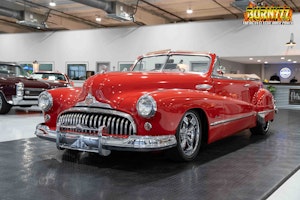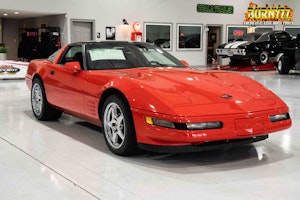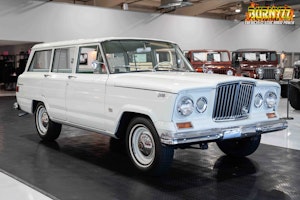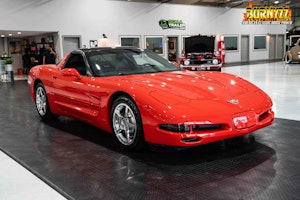Media | Articles
Scuderia Cameron Glickenhaus debuts Baja Boot at the Quail
If you’re a fan of off-road endurance racing, you’re probably familiar with the Baja Boot. The ground-breaking racer, campaigned in Baja by Steve McQueen and Bud Ekins, is instantly recognizable. It now belongs to Jim Glickenhaus, and it inspired him and his car company, Scuderia Cameron Glickenhaus, to build a modern version in both race-only and street-legal trims.
In its first public showing, the race version was on display at the Quail, complete with its 650-horsepower LT4 V-8, the same engine found under the hood of the Corvette Z06 and Camaro ZL1. The race version uses a Turbo 400 transmission, just like the original Baja Boot, and rides on 39-inch BFG tires. The street-legal version will be powered by a 460-horsepower LT1 V-8 and uses a 4L80E, essentially the electronic overdrive version of the Turbo 400. With 19 inches of wheel travel, the street version is only slightly toned down from the race suspension, which allows for 22 inches of travel.
The original Baja Boot was built by Vic Hickey, a GM engineer with lots of off-road vehicle design under his belt. Filled with gear from GM’s vast parts bin, it used Corvette axles, a Chevy 350 V-8, and a Turbo 400 automatic. The rear-mounted engine gave it better weight distribution and drove an independent suspension, novel for a vehicle of its size and performance.
It raced in the inaugural Baja 1000 in 1967 after a one-month build but didn’t finish the grueling challenge. However, its unique design and V-8 power was enough to convince McQueen to buy it and campaign it with Ekins, a fellow off-road racing fanatic and the stunt man behind the famous Great Escape motorcycle jump. McQueen and Ekins also initially had bad luck in the Boot, but in 1969 Ekins won the first-ever Baja 500 with partner Guy Jones. Another Jones driving a Ford Bronco finished in second place—Parnelli.
Marketplace
Buy and sell classics with confidence



Many of the modern Baja Boot’s styling cues and design choices can be traced to the original Boot, but lots of modern improvements were made. The short nose with minimal front overhang still allows for an amazing approach angle, and the hood-mounted headlights are still there, giving the modern Boot an even more arachnid-like appearance, perfectly suited for a desert-going creature.
One change from the original is that the new Boot uses an engine and transfer case that are divorced from the engine. It allows the engine to be much lower than on the original and places the fabricated center section of the nine-inch rear axle just below the torque tube connecting the engine to the trans. The result is a much lower center of gravity and what the SCG team estimates as a 44/56 weight distribution.
The modern Boot will also be offered in a four-door configuration that uses a pair of short, rear-hinged doors and a slightly stretched wheelbase to make room for two more passengers.
The rear passengers will be positioned more outboard than the driver and front passenger, allowing every occupant to have unobstructed forward vision, which makes for a more comfortable ride.


We had the opportunity to step inside the modern Baja Boot, and the interior is quite roomy, with lots of legroom and headroom. The four-seater packaging makes sense after seeing how wide the cabin is.
According to Jesse Glickenhaus, it will be the most capable factory SUV you can buy. To prove it, SCG plans to run the Baja Boot in the 2019 Baja 1000 in the Baja Challenge class.
SCORE doesn’t have a stock SUV class, at least not yet. When SCG shows up in 2020 with three Baja Boots to race, there should be a class for them to compete, and they’re inviting Mercedes and Lamborghini to bring their G-Wagen and Urus to go head-to-head against the Baja Boot. May the best SUV win.










